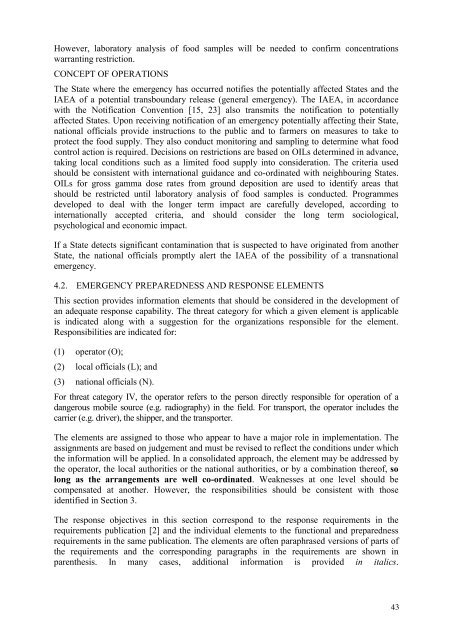epr-method (2003) - IAEA Publications - International Atomic Energy ...
epr-method (2003) - IAEA Publications - International Atomic Energy ...
epr-method (2003) - IAEA Publications - International Atomic Energy ...
You also want an ePaper? Increase the reach of your titles
YUMPU automatically turns print PDFs into web optimized ePapers that Google loves.
However, laboratory analysis of food samples will be needed to confirm concentrations<br />
warranting restriction.<br />
CONCEPT OF OPERATIONS<br />
The State where the emergency has occurred notifies the potentially affected States and the<br />
<strong>IAEA</strong> of a potential transboundary release (general emergency). The <strong>IAEA</strong>, in accordance<br />
with the Notification Convention [15, 23] also transmits the notification to potentially<br />
affected States. Upon receiving notification of an emergency potentially affecting their State,<br />
national officials provide instructions to the public and to farmers on measures to take to<br />
protect the food supply. They also conduct monitoring and sampling to determine what food<br />
control action is required. Decisions on restrictions are based on OILs determined in advance,<br />
taking local conditions such as a limited food supply into consideration. The criteria used<br />
should be consistent with international guidance and co-ordinated with neighbouring States.<br />
OILs for gross gamma dose rates from ground deposition are used to identify areas that<br />
should be restricted until laboratory analysis of food samples is conducted. Programmes<br />
developed to deal with the longer term impact are carefully developed, according to<br />
internationally accepted criteria, and should consider the long term sociological,<br />
psychological and economic impact.<br />
If a State detects significant contamination that is suspected to have originated from another<br />
State, the national officials promptly alert the <strong>IAEA</strong> of the possibility of a transnational<br />
emergency.<br />
4.2. EMERGENCY PREPAREDNESS AND RESPONSE ELEMENTS<br />
This section provides information elements that should be considered in the development of<br />
an adequate response capability. The threat category for which a given element is applicable<br />
is indicated along with a suggestion for the organizations responsible for the element.<br />
Responsibilities are indicated for:<br />
(1) operator (O);<br />
(2) local officials (L); and<br />
(3) national officials (N).<br />
For threat category IV, the operator refers to the person directly responsible for operation of a<br />
dangerous mobile source (e.g. radiography) in the field. For transport, the operator includes the<br />
carrier (e.g. driver), the shipper, and the transporter.<br />
The elements are assigned to those who appear to have a major role in implementation. The<br />
assignments are based on judgement and must be revised to reflect the conditions under which<br />
the information will be applied. In a consolidated approach, the element may be addressed by<br />
the operator, the local authorities or the national authorities, or by a combination thereof, so<br />
long as the arrangements are well co-ordinated. Weaknesses at one level should be<br />
compensated at another. However, the responsibilities should be consistent with those<br />
identified in Section 3.<br />
The response objectives in this section correspond to the response requirements in the<br />
requirements publication [2] and the individual elements to the functional and preparedness<br />
requirements in the same publication. The elements are often paraphrased versions of parts of<br />
the requirements and the corresponding paragraphs in the requirements are shown in<br />
parenthesis. In many cases, additional information is provided in italics.<br />
43

















